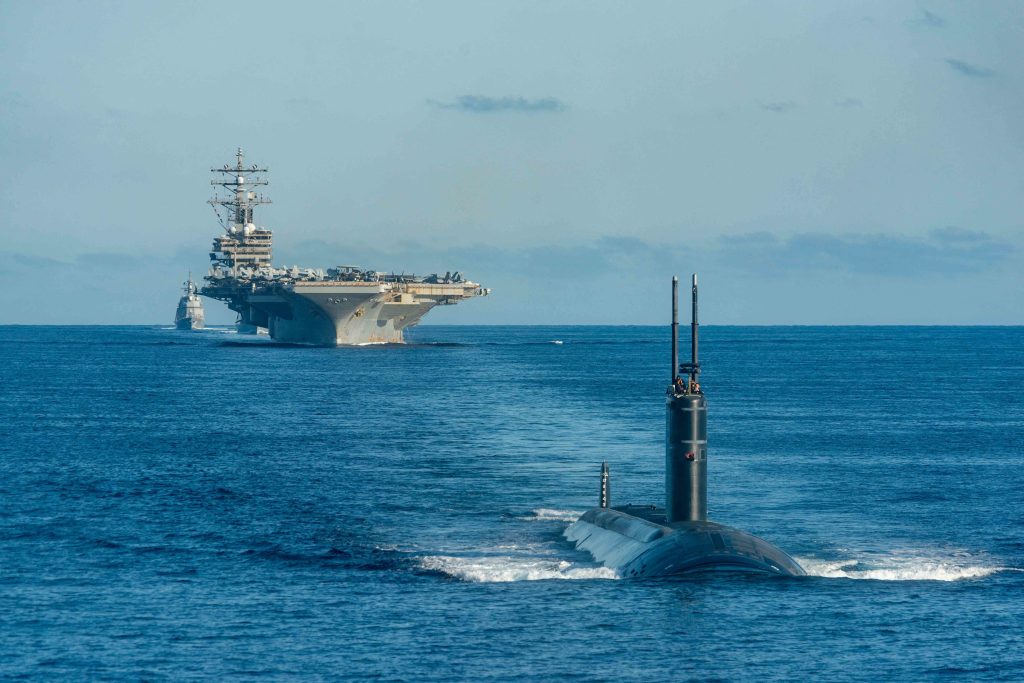The House and Senate appropriations committees have not provided adequate funding for the nuclear-armed sea-launched cruise missile (SLCM-N). This is a mistake. The United States needs this capability to deter Russia, China, and North Korea, and to assure its allies. As negotiations continue in the coming months over a final 2024 spending package, Congress has one more chance to fully fund the SLCM-N to ensure that the United States can continue to extend deterrence to its allies and partners—and therefore support international peace and security.
At a time when it is hard to find consensus in Washington, it should not go unnoticed that Republicans and Democrats in Congress have agreed to fund the nuclear modernization program begun by the Obama administration, continued by the Trump administration, and now reaffirmed by the Biden administration. That is, with one critical exception: debate continues for the second year on the value of deploying nuclear-armed cruise missiles on US attack submarines, which would help address an imbalance in nuclear forces with ranges and yields relevant to potential use at the regional level. Russia, China, and North Korea field large and growing arsenals of this kind.
Recommended by the 2018 Nuclear Posture Review of then President Donald Trump and subsequently canceled by the Biden administration, the SLCM-N program has received nominal funding from Congress to keep the program alive until the matter can be sorted out. The concept is to rearm existing Tomahawk sea-launched cruise missiles with nuclear warheads or build a variant of the next-generation nuclear-armed air-launched cruise missile—now being designed for delivery by strategic bombers—on US nuclear-powered attack submarines, which currently do not carry nuclear arms.
Fielding SLCM-Ns would demonstrate that the United States has optimal capabilities to respond to small-scale nuclear use by an adversary.
With SLCM-Ns on US submarines, Russia, China, and North Korea would not know how many nuclear cruise missiles are deployed on any given submarine, or even where those vessels are located at any given time. These states would know, however, that the United States had a survivable and prompt answer to any Russian, Chinese, or North Korean nuclear use against US forces or its allies during a regional conflict. This demonstration of resolve and capability deters adversaries and reassures allies who may wonder why the United States has not altered its regional nuclear posture since the end of the Cold War, despite the expansion of Chinese and Russian regional nuclear capabilities and the rapid emergence of North Korea’s own nuclear capabilities. Fielding SLCM-Ns would demonstrate that the United States has optimal capabilities to respond to small-scale nuclear use by an adversary. The current relative lack of flexible options for a nuclear response may leave adversaries with the mistaken notion that they could “get away with” small-scale nuclear use without facing unacceptable consequences.
The Biden administration cites cost and additional training burdens as reasons against SLCM-Ns. Its main objection, however, seems rooted in the belief recently articulated by the White House that “the US has sufficient current and planned capabilities for deterring an adversary’s limited nuclear use through conventional and nuclear armaments.” Administration officials may be right, to a certain extent. Most, though not all, targets that can be threatened with a nuclear sea-launched cruise missile can also be targeted with a strategic bomber armed with an air-launched cruise missile or a fighter aircraft carrying nuclear gravity bombs. These options, however, are not necessarily prompt, because they must be generated from the United States, except in the case of Europe, where the United States and certain allies maintain nuclear-capable fighter jets. Additionally, they cannot provide the day-to-day survivable presence available with a stealthy submarine. This is likely what General Mark Milley, chairman of the Joint Chiefs of Staff, had in mind when he wrote to Congress in June 2022 that “we continue to see value in pursuing the nuclear-armed sea-launched cruise missile to deter regional nuclear attack because of its distinct contribution.”
The point of the SLCM-N is not to hold an additional specific target set at risk, but rather to raise the level of risk to the Russians, Chinese, and North Koreans should they contemplate initial nuclear use in their respective regions to improve their military situation in a crisis or conflict or to coerce the United States to back down. For this purpose, the SLCM-N provides a tangible demonstration of US resolve to respond to any adversary’s nuclear use. Senator Angus King, chairman of the Strategic Forces Subcommittee of the Senate Armed Services Committee, made this case at a hearing in March. He said, “the formula for deterrence is ‘will’ plus ‘capacity,’ and will is a hard thing to measure and quantify… Capacity, though, is something that can be measured.” King went on to explain that the United States does not have sufficient low-yield, regional deterrent capacity and was surprised there was no funding for the SLCM-N in the fiscal year 2024 defense budget request from the White House.
Congress and the administration now should come together on what is a real test of the United States’ ability to respond to the expansion of Russian, Chinese, and North Korean nuclear capabilities.
In fact, the funding picture in Congress is complicated. The House and Senate armed services committees have authorized for fiscal year 2024 about $190 million to the Navy to develop the SLCM-N for deployment early in the next decade, as well as about $75 million to the Department of Energy for the warhead, which is likely the same version now under development for the Long-Range Standoff weapon, the replacement for the aging air-launched cruise missile. But the House Appropriations Committee provided no funding for SLCM-N when sending its bill to the floor this summer, while Senate appropriators provided $50 million when passing their bill out of committee last week. Normally, $50 million would now become the high-water mark for funding, but a potential conference committee has the leeway to fund SLCM-N at a level closer to that proposed by the authorizing committees if the appropriators can reach agreement.
Congress and the administration now should come together on what is a real test of the United States’ ability to respond to the expansion of Russian, Chinese, and North Korean nuclear capabilities. The ongoing modernization of the nuclear triad of intercontinental ballistic missiles, submarines, and bombers is a significant signal of resolve, to be sure, but the one-for-one replacement of forces deemed sufficient in 2010 may not be sufficient to simultaneously deter Russia, China, and North Korea in the future. Russia continues to enjoy a ten-to-one advantage over NATO in regional nuclear forces, while China now enjoys a monopoly in theater-range nuclear forces over the United States and its allies in the Indo-Pacific—and even North Korea has been demonstrating new theater-range missiles while displaying small nuclear warheads for them. The deployment of SLCM-Ns, even in modest numbers on some portion of US nuclear-powered attack submarines, would send a clear message to adversary and ally alike that the United States maintains the resolve and capabilities to respond to any foe’s nuclear use—which is the best way to ensure that these weapons are never used and to reduce the incentive for non-nuclear US allies such as South Korea to field their own nuclear weapons.
In addition to SLCM-N’s contributions to US response options to limited nuclear use, US allies are likely to see it as reinforcing the credibility of US extended deterrence simply because SLCM-Ns would be a capability framed as explicitly for the extended deterrence mission. It would do so without posing the formidable domestic political challenges presented by attempting to base a modernized, dedicated regional nuclear system on the ground on allied territory.
Finally, SLCM-Ns will also influence the US position on a follow-on agreement to the New START treaty that is due to expire in February 2026. Unless the United States can address the growing disparity in regional nuclear capabilities, it is hard to imagine Washington agreeing to a new treaty that would inevitably protect Moscow’s growing numerical advantage in regional nuclear forces.
Robert Soofer is a senior fellow in the Forward Defense program of the Atlantic Council’s Scowcroft Center for Strategy and Security, where he leads its Nuclear Strategy Project. Previously, he served as deputy assistant secretary of defense for nuclear and missile defense policy from 2017–2021 and as a senior staff member on the Senate Armed Services Committee.
Walter B. Slocombe is a board director at the Atlantic Council. He served as under secretary of defense for policy from 1994 to 2001. Prior to that position, he held a variety of senior roles in the Defense Department and served on the staff of the National Security Council. He currently practices law with the Washington firm of Caplin & Drysdale.
Further reading
Wed, Jun 14, 2023
Before embarking on arms control talks, Biden needs a nuclear deal with Congress
New Atlanticist By Robert Soofer
The White House and Congress disagree over the type and number of nuclear weapons needed to deter Russia, China, North Korea, and potentially Iran.
Fri, Sep 16, 2022
Memo to the president: How to deter Russian nuclear use in Ukraine—and respond if deterrence fails
Memo to... By
The US should issue vague public threats of serious consequences should Russia use nuclear weapons and be prepared to follow through with conventional military strikes if deterrence fails.
Wed, Jul 19, 2023
Experts react: South Korea embarks on a new nuclear era. How will it play out?
New Atlanticist By
US and South Korean officials just met in Seoul for the inaugural meeting of the Nuclear Consultative Group, a new bilateral platform to coordinate deterrence against a North Korean nuclear attack.
Image: A US Navy aircraft carrier strike group is moving into waters off the Korean Peninsula.



